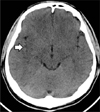Abstract
Dissecting aneurysm is not common. By the literature, motorcycle accidence is most common cause of dissecting aneurysm. Next to motorcycle accidence, perforating injury or blunt traumas occasionally could cause the dissection of artery. The authors have experienced one young adult man who admitted emergency room (ER) because of loss of consciousness, left hemiparesis and headache after violence of neck trampled down. On radiologic study, right carotid arterial dissection and acute cerebral infarction of middle cerebral artery territory were detected. Because of hemorrhagic transformation with severe brain swelling, he got decompressive craniectomy and carotid stent insertion in consecutive order. The authors present a case of carotid dissecting aneurysm after minor violence and careful observation was needed to identify.
Figures and Tables
FIGURE 1
Initial brain computer tomography (CT) taken 3 hours after violence demonstrated subarachnoid hemorrhage (arrow) on right Sylvian fissure.

FIGURE 2
Brain magnetic resonance Imaging (MRI) taken 2 days after violence. T1W (A), T2W (B), FLAIR (C) and diffusion (D) demonstrate acute ischemia of right Middle Cerebral Arterial (MCA) territory. FLAIR: fluid attenuated inversion recovery.

References
1. Berlot G, Nicolazzi G, Viviani M, Silvestri L, Tomasini A, Gullo A, et al. Traumatic blunt carotid injury: clinical experience and review of the literature. Eur J Emerg Med. 1996; 3:36–42.

2. DuBose J, Recinos G, Teixeira PG, Inaba K, Demetriades D. Endovascular stenting for the treatment of traumatic internal carotid injuries: expanding experience. J Trauma. 2008; 65:1561–1566.

3. Goyal MS, Derdeyn CP. The diagnosis and management of supraaortic arterial dissections. Curr Opin Neurol. 2009; 22:80–89.

4. Hughes KM, Collier B, Greene KA, Kurek S. Traumatic carotid artery dissection: a significant incidental finding. Am Surg. 2000; 66:1023–1027.
5. Inoue A, Fukumoto SY, Kumon Y, Watanabe H, Fumoto N, Oda S, et al. [A case of common carotid artery dissection showing remission in short-term.]. No Shinkei Geka. 2005; 33:81–85.
6. Iwamuro Y, Nakahara I, Higashi T, Watanabe Y, Matsumoto S, Takahashi K, et al. [Spontaneous improvement of idiopathic intracranial carotid artery dissection: a case report.]. No Shinkei Geka. 2008; 36:625–631.
7. Ji KY, Ahn JY, Song WS, Lee BH. Endovascular treatment for a penetrating vertebral artery injury - case report -. J Korean Neurosurg Soc. 2002; 32:578–581.
8. Kim YS, Yoon SH, Kim EY, Park HS. Spontaneous recanalization from traumatic internal carotid artery occlusion. J Korean Neurosurg Soc. 2007; 42:125–128.
9. Kwon TW, Kim SK, Kim JS. Traumatic pseudoaneuysym and arteriovenous fistula among internal and external carotid artery and internal jugular vein -Case report-. J Korean Vasc Surg Soc. 1996; 12:45–49.
10. Leys D, Lucas C, Gobert M, Deklunder G, Pruvo JP. Cervical artery dissections. Eur Neurol. 1997; 37:3–12.

12. Park SD, Won YS, Choi CS, Chung EC. Endovascular stent treatment for traumatic common carotid artery dissection with cerebral infarction: case report and literature review. Korean J Cerebrovasc Surg. 2006; 8:119–123.




 PDF
PDF ePub
ePub Citation
Citation Print
Print




 XML Download
XML Download